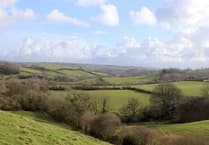Writer Nick Pannell has just published Devon’s Spiritual Places. The book explains his search for God in an ancient landscape, and took six years to research and write. The result describes his emotive journey through the wild and beautiful places in our county. The Mid-Devon Advertiser has been lucky to obtain seven signed copies of Nick’s book, and readers can enter a competition in this week’s paper.
Below is the fourth and final extract from his book we are sharing.
Nick will be talking about his book later this month. On Monday, February 27 he will be at Kingskerswell Library at 7pm to discuss his journey. Tickets cost £2 on the door and proceeds will go to support library services.
LIGHTS IN THE HEAVENS
Beardown Man, Dartmoor: In 1885, the Dartmoor writer William Crossing came across a remote standing stone in the wilderness of the northern moor. As the sun cast its dying beams he wrote:
‘As it was to the patriarchs of old, so it is to us now. It is a pillar of witness – a witness that those who reared it looked above the earth on which they trod. Looked upward and found a hope, as we may do to-day, for it is a finger that points from that which perishes, and where the day becomes spent, and loses itself in darkness, to a kingdom of light that shall endure forever.’
He was writing about the Beardown Man, an 11-foot-high block of granite raised by human hands 4,000 years ago for reasons long forgotten.
Unlike the stone rows of Merrivale or the menhirs of Drizzlecombe, it is not connected with any Bronze Age settlements but stands alone, the highest monument on Dartmoor, commanding views in all directions. Was it a waymark or meeting place, used for religious ceremony or just good parties?
I first came upon it many years ago while hiking between Fur Tor and Two Bridges.
We’d trudged for miles over featureless peat bog, with mist coming and going, and then the great stone reared up ahead and we knew exactly where we were. Today I’ve come from the opposite direction with a friend, to enjoy the landscape at sunset and a night sky beyond the glare of city lights.
We arrive for day’s grand finale, the clouds ablaze with colour until the sun emerges from behind the scenes, full and golden, for the curtain call. The star of the show takes a final bow from the silhouetted steps of Great Mis Tor and slips away.
Immediately it feels colder, the grass of the open moor that was charged with gold minutes earlier now looks white and haggard like old man’s beard, and the rocks of Devil’s Tor behind us lose their texture to become a shadowy presence.
We had hoped for a clear night to watch the stars switch on one by one, but clouds build from the west and darkness falls suddenly, dispiritingly. The distant views are gone, and soon our world has shrunk to the length of a torch beam.
We seek shelter from the wind among the granite stacks of Devil’s Tor, finding one just big enough to shield our stove and brew some tea. This gesture of civilisation in the Dartmoor wilderness, briefly lifts our spirits. We share food and tell stories, as Mesolithic hunters would have done around their fires 4,000 years before.
As the night deepens, starless and cold, I’m grateful for the company. Then Jon-Paul falls asleep and I’m left contemplating the darkness alone.
To the west is the thinnest band of light, between the cloud cover and the horizon, as the last energy of the day drains from the world and against it I catch the profile of the Beardown Man, upright and immovable. Apart from the lights of Hessary Tor, it is the only reference point, the sole focus in a deepening void.
As colourful sunsets stir the imagination and inspire lofty thoughts, so darkness depresses them. I feel like a prisoner in a windowless cell. Night has become a dungeon.
Then the walls explode. Suddenly a fireball crosses the sky illuminating not just the clouds but the whole landscape. ‘Did you see that?’ exclaims Jon-Paul who is suddenly wide awake and pointing skyward. ‘The biggest shooting star I’ve ever seen.’
Remarkably, our midnight rendezvous with the Beardown Man has coincided with a major astronomical event, observed across the south of England: a fragment of Halley’s Comet crashing to Earth.
The heavens have awakened and within minutes the veil of cloud draws back allowing the first stars of a yet far greater wonder to appear.
The night sky is the most profound of revelations, yet rarely do we stand in awe of it, opening our minds and imaginations to the distance and complexity. To our primitive ancestors it must have been a familiar spectacle, but they knew nothing of the vastness of space, of the millions of galaxies which spiral away into the distant cosmos that we now marvel at through powerful telescopes.
Yet from the beginning man has looked upwards to understand our place in the universe, where knowledge and mysteries intertwine like constellations.
The wisest of stargazers have seen enough to realise we know little, that the further we peer into space and time the greater the puzzle.
And what of the bigger questions beyond the scope of science and philosophy that seek to explain the purpose of this stellar creation?
Why there is something rather than nothing?
As we sit and ponder, I focus again on the silhouette of the Beardown Man etched now against a cloud of stars, like a bookmark in a vital page, pointing heavenward.
Despite our euphoria at having witnessed a cosmic event, both of us are getting cold and we turn for home, following a compass bearing across the dark expanse of moor.
The clouds continue to come and go, driven like ghosts across the stars and with fading torches we blunder into the usual hazards, difficult to negotiate in day, and worse at night.
At last the ground becomes more even, rising gently to an elevated amphitheatre ringed by the dim peaks of Beardown Tor.
During the hour since we left, the stars have become more brilliant and once again a break in the cloud throws open the glory of the heavens framed by granite towers. We stand bedazzled, feasting our eyes on the great constellations, star clusters and distant nebulae, and arched across them all is the glow of the Milky Way.
And in this throne room of the cosmos I sense the presence of the architect who wills us to lift our heads from the mundane and worldly, and to meditate on the infinite and unfathomable.
And I glimpse my place in this universe, a child of God destined to stand at the summit of creation, sentient and searching.
Through us the universe has become conscious of itself and staring up into the great beyond, I believe its creator is conscious of me.




